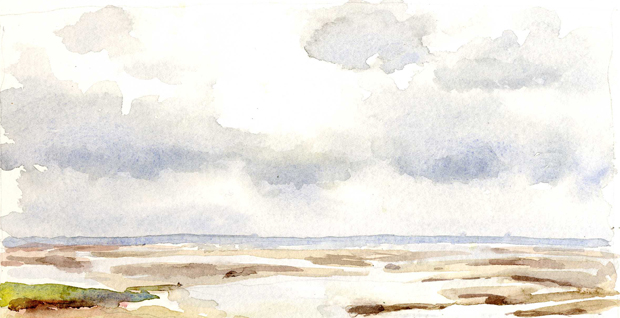In a recent conversation with a friend, I found myself saying that we can’t achieve wholeness by pulling things apart and analyzing them. To achieve wholeness requires the kind of synthesis and spacious container that art provides, a place where contradictory, even warring, elements can co-exist.
I take away a similar message from the brilliant talk by Iain McGilchrist, “The Divided Brain,” that’s illustrated in this RSA Animate video. He opens by saying that neuroscientists don’t like to talk about the division of the brain. It’s not true that one part of the brain does emotion; both are profoundly involved in both. And it’s not true that language resides only in the left hemisphere, or that visual imagery is only in the right. Important aspects of those, and other functions, reside in both hemispheres. In other words, the two sides need each other; they are both specialized and connected.
Last night, I experienced the sort of synthesis available in great art when we went to a production of Lynn Nottage’s play, “Ruined,” which won the Pulitzer Prize for Drama in 2009. Here’s the summary from her website:
“In war-torn Congo, Mama Nadi keeps the peace between customers on both sides of the civil war by serving everything from cold beers to warm beds. This shrewd matriarch both protects and profits from the women whose bodies have become battlegrounds “ruined” by the brutality of government soldiers and rebel forces alike. This play is inspired by interviews conducted in Africa.”
It certainly brought to light the issue of wars fought by men over women’s bodies, including the earth’s, yet, until the ending, I wasn’t as affected by it as the subject would suggest. Hats off to the playwright for this undertaking, for bringing such a complex, multifaceted issue to the stage. I came away thinking it would have been more heartbreaking if we understood the men better. In the play, the soldiers were, to a man, brutal, menacing rapists. Little light was shed on what made them that way, or even why they were at war.
To be fair, so much exposition was required, for instance, just to help us understand that Congolese women who’ve been kidnapped and dragged off to the bush, used by the soldiers as concubines for months, then returned to their villages, are then shunned and cast out. Their husbands and families reject them as damaged goods, so they end up in a place like Mama Nadi’s, working as prostitutes in exchange for a modicum of shelter and safety.
In the space of one play, it may not be possible also to help us understand what happened to the men. Conversations do reference child soldiers, we know a couple of the soldiers were farmers, and there is mention of mining a mineral in high demand for cell phones. In the course of the play, though, I couldn’t synthesize these seemingly random details into a coherent story about the land, the mindset of ruthless domination, the exploitation and violence. The men were uncivilized brutes, like feral dogs, exhibiting the very worst kind of wildness.
I don’t need to understand them fully, nor to sympathize, but it’s a classic dilemma of drama, when you have such bad bad guys. I speculate that Nottage would have to have a larger, eco-feminist perspective: what men do to women, they do to the earth, and vice versa, and for the same reasons. Even if she does, how could she possibly squeeze all that into one play? I imagine that the craft requires focus on one theme, and she rightly chose the women.
Mama Nadi is a strong, daring fortress. She stands up to the soldiers and has her rules: leave your bullets, if you want to be served. Lacking much of a mother figure and needing to satisfy their animal appetites of hunger, thirst, and lust, the men comply.
Apparently, there’s an ancient Egyptian hieroglyph that says there are two sources of knowledge: intuition, coming from a general intelligence, and analytical logic, coming from individual intellect. The same information can be obtained by either system, with an important difference. Information gathered by the analytical mode always leads to fragmentation and death, which that gathered by intuition always leads to wholeness and life.
I’ve never seen this dichotomy taken as far as life and death, but it does fit the play, “Ruined.” The men are busy tearing everything apart. They see the world as objects to be possessed and fought over, including the women. The women, on the other hand, have an inherent wholeness; in fact, one of them is pregnant by her earlier captors. She literally carries new life.
Mana Nadi’s impregnability, by contrast, has kept her alive and, we think, unmolested. By the end, we learn at what cost she has fought to maintain — and, indeed, regain — her wholeness.
Neat “either-or” frames like the Egyptian hieroglyph, are appealing, but they conceal the true complexities of life. Of course, as Dr. McGilchrist points out in his lecture on the divided brain, it’s both/and. The path to wholeness is only reached through synthesis, and that’s wired into our very brains.
Which makes me appreciate all the more the ending of the play, “Ruined.” Mama Nadi finally does acquiesce to the truck driver, Christian (whom she often taunts with the name “professor”), to his offer of marriage. He is a different sort of man: he is whole, himself. And when I saw just how broken and fragmented Mama really is, I was moved by her bravery and vulnerability. Hers is not the choice of a powerless victim, nor a desperate last act of survival; it comes from seeing the world with new eyes, seeing, perhaps for the first time, love. Choosing love. And a life of wholeness, a dance of opposites. And what a wise choice to carry in our hearts as we leave the theater.

